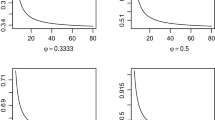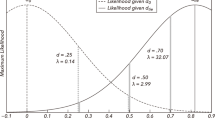Abstract
Despite an increasing interest in single-subject studies, stigmatic implications cloud the believability of ideographic (N=1) research. By comparing the assumptions of both nomothetic (large N) and ideographic research designs, a rationale for the acceptance of the results of single-subject research is proposed. The logic of experimentation, generation of the data, controls for internal and external validity, and the aspects of statistical manipulation are factors that affect all research. Believable answers to meaningful experimental questions may be generated when N=1, and it is the logic which underlies the experimental question which most clearly differentiates single-subject from group research.
Similar content being viewed by others
References
ALLPORT, G. W. 1937. Pattern and growth in personality. New York: Holt, Rinehart & Winston.
BACHRACH, A. J. 1962. Psychological research. New York: Random House.
BAER, D. M., WOLF, M. M., & RISLEY, T. R. 1968. Some current dimensions of applied behavior analysis. Journal of Applied Behavior Analysis, 1, 91–97.
BAKAN, D. 1966. The test of significance in psychological research. Psychological Bulletin, 66, 423–437.
BENJAMIN, L. S. 1965. A special Latin square for the use of each subject “as his own control.” Psychometrika, 30, 499–513. Cited by R. M. Browning, 1967. A same-subject design for simultaneous comparison of three reinforcement contingencies. Behaviour Research & Therapy, 5, 237–243.
BROWNING, R. M. 1967. A same-subject design for simultaneous comparison of three reinforcement contingencies. Behaviour Research & Therapy, 5, 237–243.
CAMPBELL, D. T., & STANLEY, J. C. 1963. Experimental and quasi-experimental designs for research. Chicago: Rand McNally.
CHASSAN, J. B. 1961. Stochastic models of the single case as the basis of clinical research design. Behavioral Science, 6, 42–50.
CHASSAN, J. B. 1967. Research design in clinical psychology and psychiatry. New York; Appleton-Century-Crofts.
DUKES, W. F. 1965. N=1 Psychological Bulletin, 64, 74–79.
EDGINGTON, E. S. 1966. Statistical inference and nonrandom samples. Psychological Bulletin, 66, 485–487.
EDGINGTON, E. S. 1967. Statistical inference from N=1 experiments. The Journal of Psychology, 65, 195–199.
ESTES, W. K. 1956. The problem of inference from curves based on group data. Psychological Bulletin, 53, 134–140.
GARRETT, H. E. 1958. Statistics in psychology and education. New York: Longmans, Green.
GEPHART, W. J., & BARTOS, B. B. 1969. Profiling instructional package, #7 Occasional Paper, Phi Delta Kappa, Research Service Center.
GENTILE, J. R., RODEN, A. H., & KLEIN, R. D. 1972. An analysis-of-variance model for the intrasubject replication design. Journal of Applied Behavior Analysis, 5, 193–198.
GURALNICK, M. J. 1973. A research-service model for support of handicapped children. Exceptional Children, 39, 277–282.
HALL, R. V., CRISTLER, C, CRANSTON, S. S., & TUCKER, B. 1970. Teachers and parents as researchers using multiple baseline designs. Journal of Applied Behavior Analysis, 3, 247–255.
HARING, N. G., & PHILLIPS, E. L. 1962. Educating emotionally disturbed children. New York: McGraw-Hill.
HYMAN, R. 1964. The nature of psychological inquiry. Englewood Cliffs: Prentice-Hall.
KERLINGER, F. N. 1964. Foundations of behavioral research. New York: Holt, Rinehart & Winston.
KOENIG, C. H. 1972. Charting the future course of behavior. Kansas City, Kan.: Precession Media.
KRANTZ, D. L. 1971. The separate worlds of operant and non-operant psychology. Journal of Applied Behavior Analysis, 4, 61–70.
LYKKEN, D. T. 1968. Statistical significance in psychological research. Psychological Bulletin, 70, 151–157.
MEEHL, P. E. 1954. Clinical versus statistical prediction. Minneapolis: University of Minnesota Press.
NUNNALLY, J. 1960. The place of statistics in psychology. Educational and Psychological Measurement, 20, 641–650.
NUNNALLY, J. 1967. Psychometric theory. New York: McGraw-Hill.
ORNE, M. T. 1962. On the social psychology of the psychological experiment: With particular reference to demand characteristics and their implications. American Psychologist, 17, 776–783.
PAUL, G. L. 1969. Behavior modification research: Design and tactics. In C. M. Franks (Ed.), Behavior therapy: Appraisal and status. New York: Mc-Graw Hill.
PLATT, J. R. 1964. Strong inference. Science, 146, 347–353.
REVUSKY, S. H. 1967. Some statistical treatments compatible with individual organism methodology. Journal of Experimental Analysis of Behavior, 10, 319–330.
ROSENTHAL, R. 1964. Experimenter outcome—orientation and the results of the psychological experiment. Psychological Bulletin, 51, 405–412.
ROSENTHAL, R. 1965. The volunteer subject. Human Relations, 18, 389–406.
ROZEBOOM, W. W. 1960. The fallacy of the null-hypothesis significance test. Psychological Bulletin, 57, 416–428.
SHAPIRO, M. B. 1966. The single case in clinical-psychological research. Journal of Genetic Psychology, 74, 3–23.
SHINE, L. C., II, & BOWER, S. M. 1971. A one-way analysis of variance for single-subject designs. Educational and Psychological Measurement, 31, 105–113.
SIDMAN, M. 1952. A note on functional relations obtained from group data. Psychological Bulletin, 49, 263–269.
SIDMAN, M. 1960. Tactics of scientific research. New York: Basic Books.
SIEGEL, S. 1956. Nonparametric statistics for the behavioral sciences. New York: McGraw Hill.
SKINNER, B. F. 1966. Operant behavior. In W. K. Honig (Ed.), Operant behavior: Areas of research and application. New York: Appleton-Century-Crofts.
TUKEY, J. W. 1960. Conclusions vs. decisions. Technometrics, 2, 1–11.
WHITE, O. R. 1971. Glossary of behavioral terminology. (2nd ed.) Champaign, Ill.: Research Press.
WHITE, O. R. 1972. A manual for the calculation and use of the median slope— a technique of progress estimation and prediction in the single case. University of Oregon, Regional Resource Center for Handicapped Children, Working Paper No. 16, 1972.
YATES, A. J. 1970. Behavior therapy. New York: Wiley.
Author information
Authors and Affiliations
Rights and permissions
About this article
Cite this article
Edgar, E., Billingsley, F. Believability When N = 1. Psychol Rec 24, 147–160 (1974). https://doi.org/10.1007/BF03394229
Published:
Issue Date:
DOI: https://doi.org/10.1007/BF03394229




